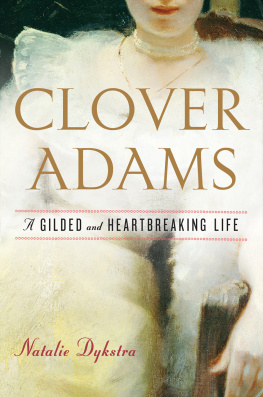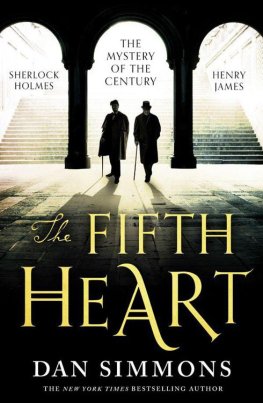Copyright 2012 Natalie Dykstra
All rights reserved
For information about permission to reproduce selections from this book, write to or to Permissions, Houghton Mifflin Harcourt Publishing Company, 3 Park Avenue, 19th Floor, New York, New York 10016.
www.hmhco.com
The Library of Congress has cataloged the print edition as follows:
Dykstra, Natalie.
Clover Adams : a gilded and heartbreaking life/Natalie Dykstra
p. cm.
Includes bibliographical references and index.
ISBN 978-0-618-87385-2
1. Adams, Marian, 18431885. 2. Historians spousesUnited StatesBiography. 3. Adams, Henry, 18381918. 4. Women photographersUnited StatesBiography. I. Title.
CT 275. A 34 D 95 2012 770.92dc23
[ B ] 2011028562
Cover design by Patrick Barry
Cover painting: Erich Lessing / Art Resource, NY
e ISBN 978-0-547-60790-0
v3.0116
In memory of Harriett M. Dykstra, 19302005
The moral is to make all one can out of life and live up to ones fingers ends.
CLOVER ADAMS, JANUARY 1, 1882
All forms of decay knock at our gate and summon us to go out into their wilderness, and yet every ideal we dream of is realized in the same life of which these things are part.
WILLIAM JAMES TO ELLEN HOOPER, OLDEST NIECE OF CLOVER ADAMS, MAY 10, 1901
Prologue
T HE AUTUMN OF 1883 was notably beautiful. Trees lining the streets of Washington, D.C., seemed to hold on to their leaves, and as the season deepened, roses and morning glories defied cooler temperatures, refusing to give up their last blooms. That fall Clover Adams celebrated her fortieth birthday. Her husband, Henry Adams, the historian and a grandson and great-grandson of American presidents, had just finished writing his second novel, Esther, and was again busy at his desk, poring over page proofs for the first section of what would become his nine-volume History of the United States During the Administrations of Thomas Jefferson and James Madison. Most mornings, Clover rode her favorite horse, Daisy, through the streets of the capital to enjoy what she called the smiling landscape, returning home to 1607 H Street with flowers for bouquets. Their home faced south to Lafayette Square, with a view of the White House in the background. The Square, also called the Presidents Park, offered a shady retreat from southern heat, a place to stroll through elliptical gardens on crisscrossing pathways lit by the yellowish glow of gaslight. At the parks center a towering bronze of Andrew Jackson reared up on horseback. Senators, vice presidents, cabinet secretaries, and military leaders occupied the stately federal-style homes that ringed the park.
Three years before, Clover and Henry had signed a lease for two hundred dollars a month for what they nicknamed the little white house, asking its owner, William Corcoran, the banker, art collector, and philanthropist, to pay for renovations, including a brand-new stable and a large detached kitchen in back. Clover considered it a solid old pile. With six bedrooms and a spacious library, the townhouse, built in 1845, was little only in comparison to the capitals grander homes, but it suited Clovers preference for what she called coziness in the New England sense. Hand-carved mantels crowned fireplaces decorated with ceramic tiles. Carpets purchased on the Adamses honeymoon to Egypt in 1872 covered the floors. An eclectic mix of Asian bronzes and porcelains were set on tables and shelves, and art, including Japanese hanging scrolls, sepia drawings by Rubens and Rembrandt, and watercolor landscapes by the English Romantics, adorned the walls. Elizabeth Bliss Bancroft, a near neighbor on H Street, once said to Clover, My dear, I dislike auctions very much, but I mean to go to yours after you die.
Clover and Henry had married eleven years before, when she was twenty-eight and he was thirty-three, joining Hooper wealth to Adams political renown. In the close quarters of Boston Brahmin society, where they had both grown up, they were a likelyif not inevitablematch. If Clover could be an undemonstrative New Englander, as she herself admitted, her practicality and quick wit tempered Henrys sometimes anxious nature. Together they enjoyed days of simultaneous fullness and leisure: a horseback ride in the morning, afternoons set aside for Henrys writing, tea promptly at five oclock for visitors, then dinner and an evenings ride or a long stretch of reading by the fireplace. They collected art, traveled, gossiped about politics, supported various causes, and attended dinners and galas, which during the high time of the social season, from mid-October until Lent, took up many evenings. Of these years, Henry wrote, This part of lifefrom forty to fiftywould be all I want.
A wide array of writers and artists, politicians and dignitaries, doctors and academics made their way to the Adamses salon for food and talk. Presidents and their families made appearances. Elizabeth Adams knew it was her Aunt Clover who brought people to their house and gave it its character and warmth. Henry James, who liked to stay with the Adamses for weeks at a time, at one point called Clover, with her satiric humor, a perfect Voltaire in petticoats and thought her an ideal specimen of a particular type of American womanpractical, honest, quick-thinking, with a streak of independence and rebellion. She read widelyGeorge Sand, William Dean Howells, Henry Jamesand she took up Greek, tackling Plato and the Greek playwrights in the original language, a passion that never faded. Though Clover sometimes battled dark moods, she was no neurasthenic who took to her bed. She used her acerbic wit to maintain perspective and had the will to manage things to suit her. Athletic but petite, at five feet two inches in height, and her husband just an inch or so taller, Clover had the legs of all chairs and sofas shortened to better fit their personal proportions. When offered a seat, much taller guests, including the six-foot-two Oliver Wendell Holmes Jr., later a Supreme Court justice, would precipitously drop onto the low seating.
Clover reserved Sunday mornings not for church but for writing a letterwhat she called her hebdomadal drivelto her widowed father. Sometimes she despaired at how her writing failed to express all she wanted to say: Life is such a jumble of impressions just now that I cannot unravel the skein in practical, quiet fashion. Oh, for the pen of Abigail Adams! But Clover need not have been intimidated by her husbands great-grandmother. In fact, her father found it hard to comply with her request that he not read her letters aloud to family and friendsshe told such interesting stories.
In early November of 1883, Clover reported that our days go by quietly and pleasantly. The lively social season had not yet begun, though it would commence in the next month, when Congress returned to session. With no children of her own to take care of, with Henry busy at his desk, and with time on her hands, she turned once more to what had absorbed much of her attention during the summer. The previous May, she had started something new: she had begun taking and printing her own photographs. She delighted in every step of the process, from selecting a subject, through exposure of the negative, to the final print. She had shown interest in photography before, by collecting Civil War stereographs and small commercial photographs of the sights she wanted to remember from her Grand Tour through Europe in 1866. Shed spent hours looking at fine art in museums around the world, amassing with Henry a large collection of watercolors and charcoals, Japanese prints and ceramics. But taking a photograph was different from looking or collecting. With her portable five-by-eight-inch mahogany camera, Clover started making art, and the process was changing her life.
On a warm, windy November afternoon, just after lunch, she decided to photograph her beloved Skye terriers in the garden behind the townhouse. She draped a bed sheet over the back fence and positioned three chairs around a small dark table, complete with tea setteapot, three cups and saucers, and a silver spoon. She placed each dog on a chair, somehow perching their front paws on the table and getting them to stay in position while she scrambled back to her camera. She took only one exposure with her new instantaneous lens, which didnt require the extended exposure of the usual drop lens. She made a careful entry in her small lined notebook where she listed her photographic experiments, giving the details: Nov 51 P.M. Boojum, Marquis & Possum at tea in garden of 1607 H. St. instantaneous,
Next page



